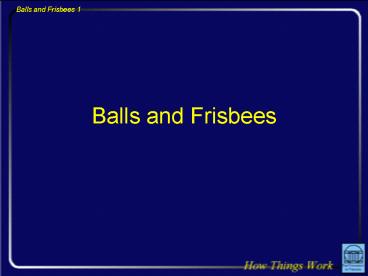Balls and Frisbees - PowerPoint PPT Presentation
1 / 20
Title:
Balls and Frisbees
Description:
Balls and Frisbees 6. Types of Drag & Lift. Surface friction causes viscous drag ... Big wake forms behind. Wake pressure is approximately ambient ... – PowerPoint PPT presentation
Number of Views:77
Avg rating:3.0/5.0
Title: Balls and Frisbees
1
Balls and Frisbees
2
Question
- A smooth, gentle river flows past a cylindrical
post. At the sides of the post, is the water
level higher, lower, or equal to its level in the
open river?
3
Observations AboutBalls and Frisbees
- Balls slow down in flight
- The greater its speed, the quicker it slows
- Spinning balls curve in flight
- Frisbees use air to support themselves
4
Aerodynamic Forces Drag
- Fluid flowing past object causes drag
- Drag Force
- results from slowing the flowing fluid
- pushes object directly downstream
- transfers downstream momentum to object
5
Aerodynamic Forces Lift
- Fluid bending at object causes lift
- Lift Force
- result from deflecting the flowing fluid
- pushes object at right angles to the flow
- transfers sideways momentum to object
6
Types of Drag Lift
- Surface friction causes viscous drag
- Turbulence causes pressure drag
- Deflected flow causes lift
- Deflected flow causes induced drag
7
Perfect Flow Around a Ball
- Outward bend in front
- high pressure, slow flow
- Inward bend on sides
- low pressure, fast flow
- Outward bend in back
- high pressure, slow flow
- Pressures balance, so only viscous drag
8
Question
- A smooth, gentle river flows past a cylindrical
post. At the sides of the post, is the water
level higher, lower, or equal to its level in the
open river?
9
Onset of Turbulence
- Fluid flowing into rising pressure slows
- It accelerates backward
- It loses speed and kinetic energy
- Fluid flowing near surface slows
- Surface layer experiences viscous drag
- It loses speed and kinetic energy
- If surface flow stops, turbulence ensues
10
Imperfect Flow, Low Speeds
- Pressure rises in front
- Pressure drops on side
- Big wake forms behind
- Wake pressure is approximately ambient
- Ball experiences large pressure drag
11
Boundary Layer
- Flow near surface forms boundary layer
- At low Reynolds number (lt100,000)
- boundary layer is laminar
- slowed by viscous drag
- At high Reynolds number (gt100,000)
- boundary layer is turbulent
- not slowed much
12
Imperfect Flow, High Speeds
- Pressure rises in front
- Pressure drops on side
- Small wake forms behind
- Wake pressure is approximately ambient
- Ball experiences small pressure drag
13
Tripping the Boundary Layer
- To reduce pressure drag
- initiate turbulence in the boundary layer (trip)
- delay flow separation on back of ball
- shrink the turbulent wake
- Examples Tennis balls and Golf balls
14
Spinning Balls, Magnus Force
- Surface pulls flow with it
- One side experiences longer inward bend
- That side has lower pressure and faster flow
- Overall flow is deflected
- Magnus lift force
15
Spinning Balls, Wake Force
- Surface pulls flow with it
- Wake is asymmetric
- Overall flow is deflected
- Wake deflection lift force
16
Frisbees
- Above Frisbee
- airflow bends inward
- low pressure, high speed
- Below Frisbee
- airflow bends outward
- high pressure, low speed
- Pressure imbalance lifts the Frisbee
17
Starting Flight
- Airflow starts symmetric
- No net deflection of air
- No lift
18
Vortex Shedding
- Trailing airflow unstable
- Vortex peals away withccw angular momentum
- Remaining airflow hascw angular momentum
19
Stable lift
- After vortex is shed,Frisbee has lift
- Air is deflected downward overall
- Frisbee is pushed upward by air
- Airflow around Frisbeehas angular momentum
20
Summary AboutBalls and Frisbees
- The air pressures around these objects are not
uniform and result in drag and lift - Balls experience mostly pressure drag
- Spinning balls experience Magnus and Wake
Deflection lift forces - A Frisbees airfoil shape allows it to deflect
the air to obtain lift































